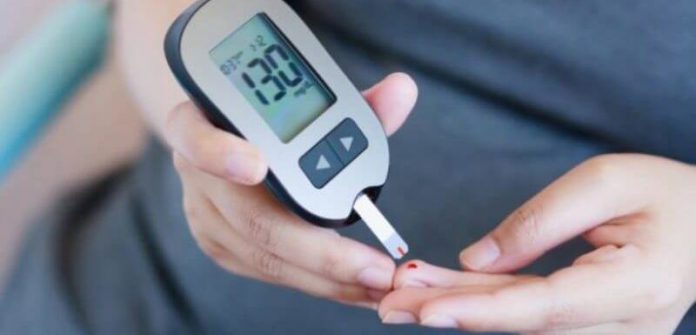What is a glucometer?
A glucometer is that little machine used to measure your level of sugar (i,e glucose) in your body. If you are diabetic, take care of a diabetic person, chances are you have seen a glucometer being used in a hospital, pharmacy or a clinic.

Glucometer being used to measure blood sugar levels.
What is the importance of measuring blood sugar levels?
There are several benefits of monitoring blood sugar levels in a diabetic person.
- Diagnosis of diabetes either as Type I or Type 2
- Allows decision making at to what treatment measures to use. For example the levels of glucose can tell us if exercise and diet are adequate.
- Tell us when to introduce medications
- Tell us when to suspend medication
- Tell us when to change medication
- Tell us when to change dosage of diabetes medications
meter, also known as a glucose monitor or a glucometer, plays a key role in managing diabetes. It can tell you at a glance what your blood sugar is in the moment—important information that should guide your food choices and how much you eat, your activity level, and, if you take insulin, your next dose.
Beyond that, keeping a log of readings can give you and your doctor an overall picture of how your body responds to certain foods, exercise, medicine, and other factors. Regular monitoring also can help you stay as healthy as possible. In fact, regular glucose testing can greatly reduce the risk of developing long-term complications in diabetes.1
Portable glucose monitors are available over the counter at drugstores and other stores that sell pharmaceutical products. They can also be purchased from online stores like Amazon and pharmacy websites. Some doctors and diabetes educators also stock glucometers.
Your doctor or a certified diabetes educator can help you decide which glucometer best meets your needs (one that monitors blood sugar continuously, for example, or one that requires a minimal amount of blood). Learning all you can about how blood glucose meters work and the wide variety of features and options to consider when purchasing one can help you to make an informed decision.
Basic Blood Glucose Meters
At its simplest, a glucometer is a hand-held instrument with a digital screen that’s used with disposable test strips treated with chemicals that react to glucose. Some glucose meters come with a lancing device—an instrument that uses a spring-loaded needle to create a tiny puncture in the skin, from which a blood sample is obtained. Lancing devices and lancets can be purchased separately, however, and the size of the lancet can be adjusted depending on personal comfort.
To get a blood glucose measurement, a person draws a blood sample (usually from the side of a fingertip) and carefully touches it to a test strip that’s been inserted into the device.2 The test strip absorbs the blood, and then an electronic circuit detects the glucose on the strip, displaying it as a number on the screen, usually within seconds.Step-by-step Guide to Using a Glucometer
Most meters run on batteries and have at least a minimal amount of memory for storing results. With very few exceptions, most also have the capability to download and store results to a computer.
But there are other features to consider, such as:
- A backlit screen, which makes it easier to read results
- A portlight that illuminates where test strips are inserted
- Wireless Bluetooth capability, so that results can be downloaded to a smartphone app where data can be stored
- Cloud storage capability
- USB rechargeable batteries
- Ability to provide an accurate result with a 0.3-microliter blood sample (the smallest amount possible; particularly advantageous for testing children)
- Voice technology, meaning the meter can “say” the results aloud (a great feature for people with diminished eyesight)
- Alternate site testing, meaning blood can be sampled from a place on the body other than the fingertip, such as the forearm, palm, thigh, or calf, depending on the specifications of the meter
- Measures blood pressure (as well as blood sugar)
- Measures ketones (as well as blood sugar)
